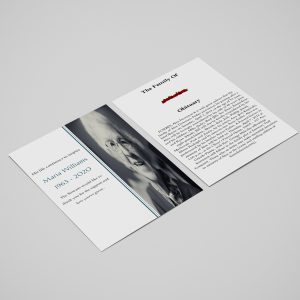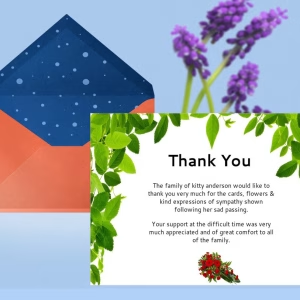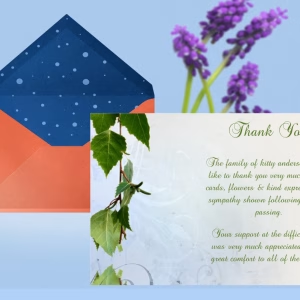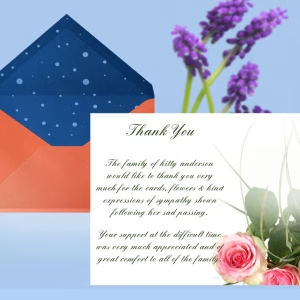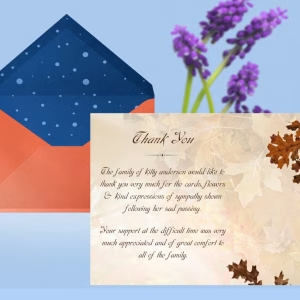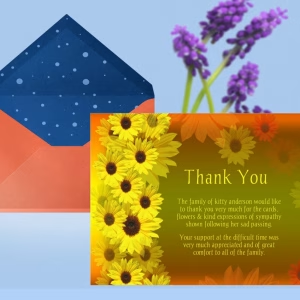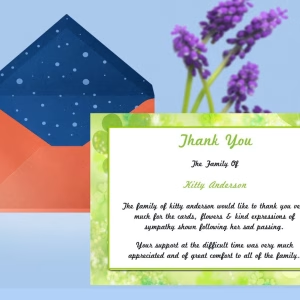In the aftermath of a funeral, expressing gratitude to those who offered support, condolences, and assistance is a heartfelt gesture. One of the most traditional ways to show appreciation is by sending thank you cards. However, knowing how to properly address these cards can be challenging, especially when emotions are still raw. This guide will help you navigate the process of addressing thank you cards for a funeral with care, ensuring your messages are both appropriate and sincere.
Why Sending Thank You Cards Matters
Sending thank you cards after a funeral is a time-honored tradition that offers several important benefits:
- Showing Appreciation: It acknowledges the kindness of those who attended the funeral, sent flowers, made donations, or offered any form of support.
- Offering Closure: For many, writing thank you cards can be a part of the healing process, providing a sense of closure as you express your gratitude.
- Strengthening Bonds: It helps maintain and strengthen relationships with friends, family, and acquaintances who were there for you during a difficult time.
Who Should Receive a Thank You Card?
Before diving into the specifics of addressing thank you cards, it’s important to understand who should receive them. Generally, you should send a thank you card to:
- Pallbearers: Individuals who carried the casket or played a significant role in the funeral service.
- Those Who Sent Flowers or Donations: Anyone who sent flowers, a memorial donation, or other gifts in honor of the deceased.
- Attendees: Close friends and family members who attended the service, especially if they traveled a long distance.
- Clergy and Funeral Staff: The officiant, funeral home staff, or anyone who provided professional services during the funeral.
- Meal Providers: Those who provided food, either during the wake or after the funeral.
How to Address Thank You Cards for a Funeral
1. Start with the Recipient’s Name
When addressing a thank you card, it’s essential to personalize it by using the recipient’s name. This small detail makes the note feel more sincere and less like a formality.
- Formal Titles: If the recipient holds a formal title (e.g., Dr., Rev., or Prof.), include it in the address. For example: Dr. John Smith.
- Couples: For married couples, you can address the card to both individuals, using their full names. For example: Mr. and Mrs. John and Jane Smith.
- Families: If you’re addressing a thank you card to a family, you can use the family name, such as The Smith Family.
2. Addressing Close Friends and Relatives
When addressing close friends or relatives, you can be more casual. Use their first names if it feels appropriate:
- Dear Aunt Susan and Uncle Bob,
- Dear Sarah,
Being more personal with those close to you reflects the intimacy of the relationship and the sincerity of your gratitude.
3. Addressing Groups or Organizations
If you need to thank a group or an organization, such as a workplace or church group that made a collective contribution, address the card to the group as a whole:
- Dear Staff at ABC Corporation,
- To the Congregation of St. Mary’s Church,
You can also mention specific individuals within the group if you’re aware of their contributions.
4. Use of Honorifics and Titles
Honorifics (Mr., Mrs., Dr., etc.) should be used when addressing individuals in a formal context, such as acquaintances, business associates, or older relatives. Here’s how to correctly apply honorifics:
- Single Woman: Ms. Jane Doe (if you’re unsure of marital status) or Miss Jane Doe.
- Married Woman: Mrs. John Doe or Mrs. Jane Doe.
- Married Couple: Mr. and Mrs. John and Jane Doe.
- Widowed Woman: Mrs. Jane Doe is preferred, as it honors her connection to her late spouse.
- Divorced Woman: If she has reverted to her maiden name, use Ms. Jane Doe.
5. Handwriting vs. Printing the Address
For a personal touch, handwrite the recipient’s address on the envelope. Handwritten addresses add warmth and sincerity, making the recipient feel valued. However, if you have many cards to send, or your handwriting is difficult to read, printing the addresses is also acceptable.
6. Inner and Outer Envelopes
Traditionally, formal thank you cards include an inner and outer envelope. The outer envelope is used for mailing, while the inner envelope, which contains the card, is addressed more informally.
- Outer Envelope: Mr. and Mrs. John Doe, 1234 Maple Street, Springfield, IL 62704.
- Inner Envelope: John and Jane.
This tradition is not mandatory, but it can add a formal touch, especially for very close family members or dignitaries.
What to Include in the Thank You Card
1. Opening Salutation
Start with a warm and appropriate salutation. For example:
- Dear Mr. and Mrs. Smith,
- Dearest Sarah,
2. Expressing Gratitude
Clearly state what you’re thanking them for. Be specific, as it shows that you remember and appreciate their particular act of kindness:
- Thank you so much for the beautiful flowers you sent for Mom’s funeral. They brought a great deal of comfort to us all.
- We are deeply grateful for your generous donation in Dad’s memory. It means the world to us that you honored him in this way.
3. Personal Reflection (Optional)
Including a personal reflection or memory can add depth to your thank you note:
- Mom always loved roses, and the arrangement you sent reminded us of her garden.
- Dad spoke often about your friendship, and I know he would have been touched by your thoughtful gift.
4. Closing Remarks
End your card with a closing remark that feels right for your relationship with the recipient:
- With heartfelt thanks,
- Sincerely,
- With love and appreciation,
5. Signature
Sign the card with your name or the names of your immediate family members. If multiple family members are contributing, consider signing as a family:
- The Smith Family
- Jane, John, and Sarah
Additional Tips for Sending Funeral Thank You Cards
1. Timing
While it’s ideal to send thank you cards within two to three weeks of the funeral, it’s understandable that grief may delay this process. Most people understand that it can take time, so don’t pressure yourself to send them too quickly. It’s more important that the cards are sincere than prompt.
2. Keeping Track
To avoid overlooking anyone, keep a list of people who should receive a thank you card. This list can include those who signed guest books, made donations, sent flowers, or provided food. Assigning this task to a trusted friend or family member can help if you feel overwhelmed.
3. Choosing the Right Stationery
Select thank you cards that reflect the tone you wish to convey. Simple, elegant designs are usually best for funeral thank you notes. If the deceased had a favorite color or symbol, you might choose cards that incorporate these elements.
4. Sending a Group Thank You Card
If a large group of people contributed together (like a workplace), it’s often acceptable to send a single thank you card addressed to the group, especially if the individual contributors are unknown.
5. Hiring Help
If writing and addressing the cards feels too overwhelming, consider enlisting help from family members or hiring a professional service. They can assist with the logistical aspects while ensuring the cards are sent in a timely and respectful manner.
Sample Thank You Card Wording
For a Flower Arrangement
Dear [Name],
Thank you so much for the lovely flower arrangement you sent in honor of [Deceased’s Name]. The roses were beautiful and brought comfort to all of us during this difficult time. Your thoughtfulness is greatly appreciated.
With gratitude,
[Your Name]
For a Donation
Dear [Name],
We deeply appreciate your generous donation in memory of [Deceased’s Name]. It is comforting to know that [his/her] legacy will continue through your kindness. Thank you for your support and thoughtfulness.
Sincerely,
[Your Name]
For a Meal Provided
Dear [Name],
Thank you for providing the delicious meal after [Deceased’s Name]’s service. It was such a relief to have one less thing to worry about, and your kindness meant so much to us. We are truly grateful.
Warm regards,
[Your Name]
Knowing how to address thank you cards for a funeral is an important part of expressing gratitude during a time of loss. By following these guidelines, you can ensure that your messages are thoughtful, respectful, and sincere. Remember that the act of sending a thank you card is not just about etiquette—it’s a meaningful way to honor the memory of your loved one and acknowledge the support you received. Take your time, be sincere, and don’t hesitate to seek help if needed. Your efforts will be deeply appreciated by those who stood by you during this difficult time.
Funeral Thank You Card Templates
-
Searching for a Simple Funeral Thank You Card Template that is easy to print and amass and that has a cutting-edge look? This Simple Funeral Thank You Card Template is the Perfect decision that is having a measure of 8.5”x 5.5”.
- No Limitation on Content, Edit anything
- Edit anytime – unlimited revisions even after purchased
- Get printable PDF downloaded to get it printed your own.
-
Searching for a Green Leaf Thank You Card template that is easy to print and amass and that has a cutting-edge look? This Green Leaf Thank You Card Template is the Perfect decision that is having a measure of 5.5”x 8.5”.
- No Limitation on Content, Edit anything
- Edit anytime – unlimited revisions even after purchased
- Get printable PDF downloaded to get it printed your own.
-
Searching for a Natural Thank You Card Template that is easy to print and amass and that has a cutting-edge look? This Natural Thank You Card Template is the Perfect decision that is having a measure of 5.5”x 8.5”.
- No Limitation on Content, Edit anything
- Edit anytime – unlimited revisions even after purchased
- Get printable PDF downloaded to get it printed your own.
-
Searching for a Pink Rose Thank You Card Template that is easy to print and amass and that has a cutting-edge look? This Pink Rose Thank You Card Template is the Perfect decision that is having a measure of 5.5”x 8.5”.
- No Limitation on Content, Edit anything
- Edit anytime – unlimited revisions even after purchased
- Get printable PDF downloaded to get it printed your own.
-
Searching for a Autumn Thank You Card Template that is easy to print and amass and that has a cutting-edge look? This Autumn Thank You Card Template is the Perfect decision that is having a measure of 5.5”x 8.5”.
- No Limitation on Content, Edit anything
- Edit anytime – unlimited revisions even after purchased
- Get printable PDF downloaded to get it printed your own.
-
Searching for a Floral Thank You Card Template that is easy to print and amass and that has a cutting-edge look? This Floral Thank You Card Template is the Perfect decision that is having a measure of 5.5”x 8.5”.
- No Limitation on Content, Edit anything
- Edit anytime – unlimited revisions even after purchased
- Get printable PDF downloaded to get it printed your own.
-
Searching for a Irish Green Thank You Card Template that is easy to print and amass and that has a cutting-edge look? This Irish Green Thank You Card Template is the Perfect decision that is having a measure of 5.5”x 8.5”.
- No Limitation on Content, Edit anything
- Edit anytime – unlimited revisions even after purchased
- Get printable PDF downloaded to get it printed your own.
Funeral Programs : Helping Videos
Frequently Asked Question On How To Address Thank You Cards For Funeral
How soon should I send thank you cards after a funeral?
Ideally, you should send thank you cards within two to three weeks after the funeral. However, if you need more time due to grief or other circumstances, it’s perfectly acceptable to take longer. Most people understand that this is a difficult time and will appreciate the gesture whenever it’s received.
Who should receive a thank you card after a funeral?
Thank you cards should be sent to those who provided support in various ways, including those who attended the funeral, sent flowers, made donations, provided meals, or helped with the funeral arrangements. Additionally, clergy members, pallbearers, and the funeral home staff should also be acknowledged.
Should I address the thank you card to an individual or a family?
This depends on the situation. If you are thanking a specific person, address the card to that individual. If a family or couple provided support, you can address the card to the family (e.g., “The Smith Family”) or to the couple (e.g., “Mr. and Mrs. John Smith”).
How do I address a thank you card to a group or organization?
It is not necessary to send thank you cards to everyone who attended the funeral. Focus on sending cards to those who went out of their way to offer support, such as by sending flowers, making donations, or providing other assistance.
What should I write in a thank you card for a funeral?
In a funeral thank you card, express your gratitude for the specific act of kindness, such as sending flowers, making a donation, or attending the service. You can also include a personal reflection or memory if appropriate. Close with a sincere remark, such as “With heartfelt thanks” or “With love and appreciation.”


